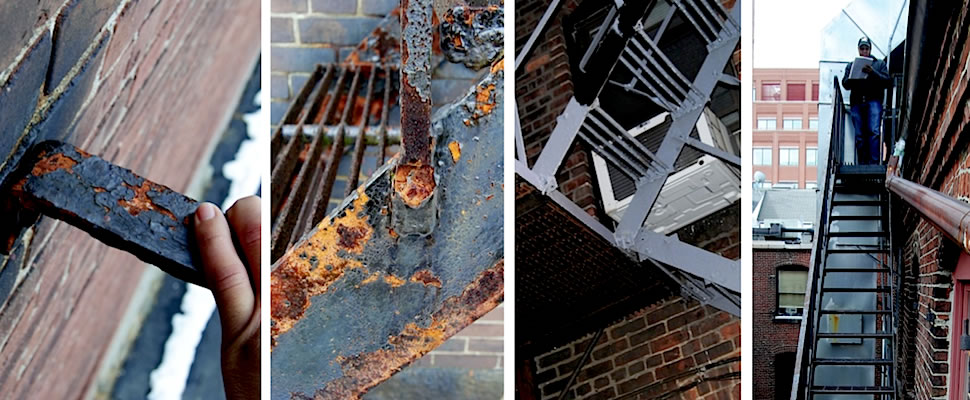ALL CODES IN THE US, FIRE CODE, BUILDING CODE AND HOUSING CODE ALL REQUIRE THE FOLLOWING IN EVERY STATE.
- ALL FIRE ESCAPES MUST BE INSPECTED AND CERTIFIED AS PER CODE
- MUST BE PERIODICALLY PAINTED TO CONTROL ALL SURFACE RUST
- MUST BE STRUCTURALLY SOUND AT ALL TIMES AND OR PROVEN 1-5 YRS
- MAINTENANCE OF EXITS FROM ANY OBSTRUCTIONS TYPICAL CODE IN EVERY STATE.
THE CODE
NFPA Life safety Code 101 7.2.8.6.2 the authority having jurisdiction shall be permitted to approve any existing fire escape Stair that has been shown by load test or other satisfactory evidence to have adequate strength.
International Fire Code Testing and Certification: All Exit discharge, exterior stairways and fire escapes shall be kept free of snow and ice. Any fire escape or exterior stairway found to be in a state of deterioration or determined to be unsafe by the fire official shall be repaired immediately. Depending upon the structural condition, a load test of any fire escape shall be conducted before the escape is returned to service.
International Building Code Testing and Certification: All exterior bridges, steel or wooden stairways, fire escapes and egress balconies shall be examined and or tested, and certified for structural adequacy and safety every five years, by a Mass registered professional engineer or other qualified and acceptable to the building official, who shall then submit an affidavit to the building official.
OBSTRUCTIONS
It shall be unlawful to obstruct, or reduce in any manner, the clear width of any doorway, hallway, passageway or other means of egress required by the provisions of this regulation.
MAINTENANCE: All exterior stairways and fire escapes shall be kept free of snow and ice. Exterior stairways and fire escapes constructed of materials requiring the application of weather protecting products, shall have these products applied in an approved manner and shall be applied as often as necessary to maintain the stairways and fire escapes in safe condition where corrodible structural parts of such stairways and fire escapes tie directly into the building structural system, all joints shall be sealed as necessary, to prevent water from damaging or corroding structural elements.
TESTING AND CERTIFICATION
All exterior bridges, steel or wooden stairways, fire escapes and egress balconies shall be OPERATIONAL AT ALL TIMES and or be examined and/or tested and certified for structural adequacy and safety every one to five years (depending on local or state laws) by a State registered professional structural engineer, or others qualified and acceptable to the building official; said engineer or others shall then submit an affidavit to the building official.
THE FIRE ESCAPE LAW IN SIMPLE TERMS
OBSTRUCTIONS
Keep a clear path free of bikes, trash, toys and anything that is a trip hazard during the night. No AC’s or bars with locks in the windows to the fire escape. No furniture or plants in the window preventing your escape during a fire or emergency.
MAINTENANCE
If snow accumulates then you must clear it of snow and ice. You must spot paint all surface rust every 1-3 years and Full Paint the entire Fire Escape every 7-10 years or as needed based on age and deterioration. Silicone shut all connections to prevent any connection becoming suspect in the future.
TESTING AND CERTIFICATION
Only Structural Engineers are automatically qualified to the Inspector. All others (Engineer also) must qualify with the Inspector by calling and then sending via Email or Snail Mail to the Inspector his/her Qualifications, Sample Inspection Reports, Repair Guidelines and Inspection Criteria to keep on file and confirm that the Violation will be removed as per criteria. Most States have the “Must be operational at all times” requirement in the Code which requires that the owner examine the fire escape constantly and this becomes the “If it ain’t Broke don’t Fix it rule”. Owners will only fix it when a code official sees a Violation (written or verbal) and by then there is more than just surface rust on the fire escape there is also structural connections that are compromised. Because of this issue other states have changed their code to require “examination and or testing every 1-5 years”. “Examined and or Tested” means a visual inspection of all connections(visible and hidden), with a signed Fire Escape Confidence Test, Certifying (guaranteeing) the Fire Escape System and all connections otherwise a LOAD TEST must be performed, as per submitted criteria, on the entire Fire Escape System to Certify the entire Fire Escape System with NO DISCLAIMERS to the owner ON ANY critical major structural components. If repairs are needed a Full Report with Photos must be submitted to official along with Repair Permit, 3-5 site visits by Structural Engineer who will oversee all repairs prior to allowing full paint job to start and Final Sign Off on Repair Permit by Code Official. EPA Rules apply on all fire escapes older than 1978 that are presumed to have LEAD. Must have a Renovators Lic. to paint a fire escape or face fines of $35,000 or more per violation.

